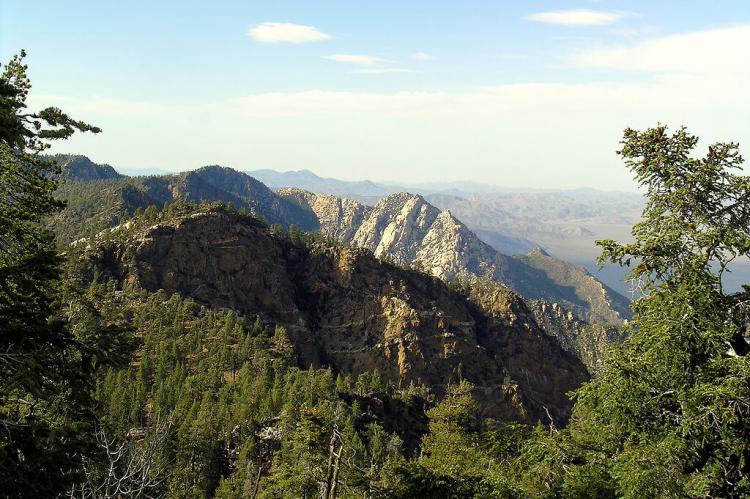The Sierra Juarez and San Pedro Martir Pine–Oak Forests: A Coniferous Oasis in Northern Baja California
The Sierra Juarez and San Pedro Martir pine–oak forests ecoregion is a temperate coniferous forest biome in the northern Baja California Peninsula, Mexico. It is a unique ecosystem that rises from the surrounding desert landscapes as an elevational oasis of diverse and endemic species.
The Sierra Juarez and San Pedro Martir Pine–Oak Forests: A Coniferous Oasis in Northern Baja California
Nestled within the northern reaches of the Baja California Peninsula in northwestern Mexico, the Sierra Juarez and San Pedro Martir pine–oak forests ecoregion is a remarkable temperate coniferous forest biome. This relatively small ecosystem is a unique western counterpart to the "sky islands" found in northern Mexico and southwestern Arizona. It is an elevational oasis of diverse and endemic species rising from the surrounding desert landscapes.
Geographic Location and Boundaries
The California chaparral and woodlands bound the Sierra Juarez and San Pedro Martir pine–oak forests ecoregion to the west, the Baja California Desert to the southwest, and the Sonoran Desert to the east. It encompasses the higher elevations of the Sierra Juárez and Sierra San Pedro Mártir mountain ranges, which form part of the Peninsular Ranges System and constitute the northernmost elevated peaks of Baja California state.
Topography and Hydrology
These granitic mountains range from 1,100 to 2,800 meters (3,600 to 9,200 feet) above sea level and are characterized by young, rocky soils that are poorly developed, shallow, and low in organic matter. The Las Palmas, Guadalupe, San Antonio, San Telmo, and El Rosario are among the many rivers that drain the mountain slopes.
Climate and Precipitation
The region exhibits a temperate subhumid climate, with winter rains and the highest annual precipitation levels in the peninsula, ranging from 400 to 700 millimeters (15 to 27 inches). This higher-than-average rainfall has led some researchers to consider this ecoregion as having a more Mediterranean climate, one of the few found within Mexico.
Unique Biodiversity
Floristic Diversity
The conifer forests in the Sierra Juarez and San Pedro Martir are unique to Mexico. They are the only multi-species Mediterranean-climate forests in the country. The Sierra de Juárez is particularly notable for its pine tree diversity, with at least ten species of Pinus inhabiting the steep mountain slopes.
San Pedro Martir is home to some of the largest pine trees in Mexico, including the Pinus lambertiana, which can reach up to 70 meters (230 feet) in height, with cones up to 70 centimeters (28 inches) in length. Other dominant species include the Parry pinyon (Pinus quadrifolia), Jeffrey Pine (Pinus jeffreyi), lodgepole pine (Pinus contorta), sugar pine (Pinus lambertiana), white fir (Abies concolor), and incense cedar (Libocedrus decurrens). The herbaceous stratum is formed by Bromus sp. and big sagebrush (Artemisia tridentata), while epiphytes and fungi are abundant throughout the forests.
Faunal Diversity
The region's unique biota comprises many endemic and endangered species. Characteristic mammals include the Ornate shrew (Sorex ornatus), puma (Puma concolor), fringed Myotis bat (Myotis thysanodes), California chipmunk (Tamias obscurus), bobcat (Lynx rufus), coyote (Canis latrans), and bighorn sheep (Ovis canadensis).
Avian species found in the ecoregion include the rare bald eagle (Haliaeetus leucocephalus), California condor (Gymnogyps californianus), pinyon jay (Gymnohinus cyanocephalus), and white-breasted nuthatch (Sitta carolinensis).
Conservation Efforts and Challenges
Protection Status
While many of these forests remain intact, primarily due to their inaccessibility, certain areas have faced deterioration from cattle farming and intense fires. Mistletoe and insect infestations have also weakened older tree systems. In 1989 and 1996, fires consumed 27 square miles (70 square kilometers) and 23 square miles (60 square kilometers) of the forest, respectively.
The California condor, once a common sight in the mountains of northern Baja California, disappeared around 1937 due to hunting and poisoning. However, conservation efforts are underway, and Sierra de San Pedro Mártir National Park encompasses 72,909 hectares (180,160 acres) within the Sierra de San Pedro Mártir mountain range.
Ongoing Threats and Future Outlook
Despite the protected status of parts of the ecoregion, the Sierra Juarez and San Pedro Martir pine–oak forests face ongoing threats from human activities, climate change, and natural disturbances. Continued monitoring, conservation efforts, and sustainable management practices are crucial to preserving this unique coniferous oasis and its remarkable biodiversity for future generations.
